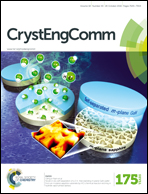Highly thermostable lanthanide(iii) MOFs constructed from 4,4′,4′′-s-triazine-2,4,6-triyl-tribenzoate ligand: synthesis, structure, and tunable white-light emission†
Abstract
A series of highly thermally stable lanthanide metal–organic frameworks formulated as [Ln2(TATB)2(DMSO)6]·DMF·DMSO·H2O [Ln = La (1), Ce (2), Pr (3), Sm (4), Eu (5)] and [Ln2(TATB)2(DMSO)5(CH3OH)]·DMF·DMSO·2H2O [Ln = Nd (6), Gd (7), Tb (8)] (TATB3− = 4,4′,4′′-s-triazine-2,4,6-triyl-tribenzoate, DMF = N,N-dimethylformamide and DMSO = dimethylsulfoxide) have been successfully synthesized under solvothermal conditions and characterized by single crystal X-ray diffraction, infrared (IR) spectroscopy, elemental analysis, thermogravimetric analyses (TGA) and powder X-ray diffraction (PXRD). Single crystal X-ray diffraction analysis reveals that all of the compounds are isomorphous, crystallize in the triclinic space group ![[P with combining macron]](https://www.rsc.org/images/entities/i_char_0050_0304.gif) 1 and exhibit two-dimensional (2D) (3,3)-connected layered structures with the Schläfli symbol {63}. Solid-state photoluminescence measurement illustrates that compounds 5 and 8 exhibit remarkable red and green luminescence emissions with lifetimes at the millisecond scale, respectively, while complexes 3, 4, and 6 display characteristic luminescence emissions in the near-infrared region. With careful adjustment of the relative concentration of the doping Eu3+ and Tb3+ ions in the La3+ complex, the color of the luminescence can be modulated, and white-light emitting materials can be successfully obtained.
1 and exhibit two-dimensional (2D) (3,3)-connected layered structures with the Schläfli symbol {63}. Solid-state photoluminescence measurement illustrates that compounds 5 and 8 exhibit remarkable red and green luminescence emissions with lifetimes at the millisecond scale, respectively, while complexes 3, 4, and 6 display characteristic luminescence emissions in the near-infrared region. With careful adjustment of the relative concentration of the doping Eu3+ and Tb3+ ions in the La3+ complex, the color of the luminescence can be modulated, and white-light emitting materials can be successfully obtained.


 Please wait while we load your content...
Please wait while we load your content...